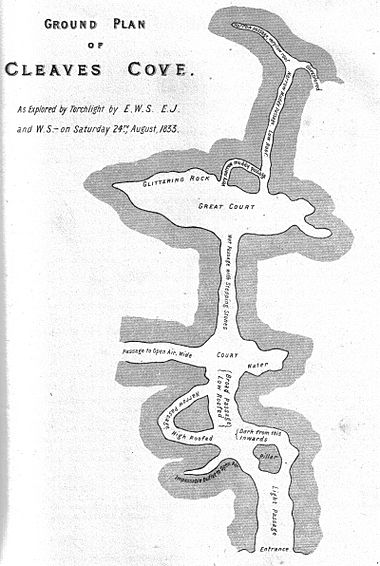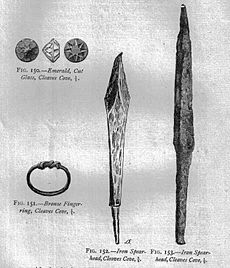Cleeves Cove facts for kids
Quick facts for kids Cleeves Cove |
|
|---|---|
| Blair Cove | |

An entrance into Cleeves Cove
|
|
| Location | Dalry, North Ayrshire |
| OS grid | NS 3717 4745 |
| Length | 500 feet (150 m) |
| Elevation | 190 feet (58 m) |
| Entrances | 3 |
| Difficulty | Easy |
| Hazards | Access path |
| Access | Hazardous |
Cleeves Cove, also known as Blair Cove, is a cool solutional cave system in North Ayrshire, Scotland. It's found near the town of Dalry, right by the Dusk Water.
Contents
Exploring the Cave System
The Cleeves Cove caves are carved into Carboniferous limestone, which is a type of rock formed from ancient sea creatures. The whole cave system is about 500 feet (150 m) long! Today, the caves are high above the Dusk Water, near Cleeves Farm and Blair Mill. Sadly, some of the amazing stalactites (rock formations hanging from the ceiling) and stalagmites (rock formations growing from the floor) have been damaged by visitors over time. There are three easy-to-reach entrances to the cave that face the Dusk Water.
A Look Back in Time
The word cove in Scots means 'cave'. Long ago, people called this place the 'Elfhouse' or 'Elfhame'. They believed that magical creatures lived here!
The caves were formed by the Dusk Water flowing through and slowly wearing away the limestone. After a while, the water level dropped, and the caves became drier. This allowed the beautiful stalactites and stalagmites to grow. Later, soil washed in from above, partly filling the caves.
In 1883, a man named John Smith got permission to explore the caves. He and his team removed about 300 tons of dirt and rock! Because of this work, the cave now sits about 40 feet (12 m) above the Dusk Water. Inside, there's a large room that's about 35 feet (11 m) long, 27 feet (8.2 m) wide, and 12 feet (3.7 m) high. The cave walls are covered in interesting rock formations, and many small passages branch off in different directions.
What John Smith Found
John Smith worked at night with six volunteers for six months. They carefully dug through the dirt, sifting it to find hidden treasures.
During his digging, John Smith found many old objects made by humans. These included a flint knife, a bone spoon, bronze finger-rings, spear heads, parts of a horse's bridle, an iron battle-axe, and even a shiny cut-glass emerald! He also found bones from many animals like beavers, sheep, hares, rabbits, cats, dogs, and various birds. Seeds from fourteen different kinds of plants were also discovered.
Who Lived Here?
Evidence like charcoal suggests that fires were lit inside the caves. This means humans used the caves at different times. They might have used them as temporary shelters or as safe places to hide during difficult times. For example, local Covenanters used the caves as a refuge. The Covenanters were people who followed a certain religion and were sometimes persecuted by the government in the 1600s. They would even hold secret meetings in the glen.
Of course, the caves have also been home to many animals over the years, such as foxes, bats, spiders, and moths.
The Elfhame Legend
Local stories say that Cleeves Cove was the "Elfhame o'the Blair," meaning the home of the elves. People believed that on Halloween, elves would ride out of the caves on tiny horses, with their long yellow hair flowing. They would drink wine from acorn cups under toadstools. Their clothes were made of green velvet, and their arrows were tipped with poison from hemlock plants.
The Cholera Burial Site
Near the Dusk Water, there's a low stone wall that marks a burial site. It's said to be where a family member from Cleeves Farm was buried during a time when a serious illness called cholera spread through the area. Local stories mention that a group of trees also marks another one of these burial sites.
Views of the Cave Complex
Auchenskeith Quarry
Close by, there was an old limestone quarry called Auchenskeith Quarry. In the mid-1800s, a special railway line ran to this quarry and its limekilns (ovens used to process limestone).
Other Covenanters Caves
Cleeves Cove isn't the only cave in Scotland linked to the Covenanters. Other famous ones include Dunton Cove and Peden's Cave.











